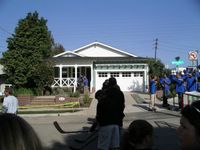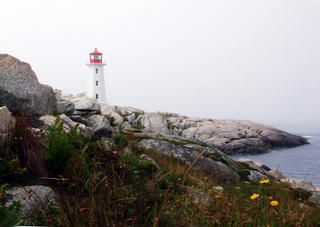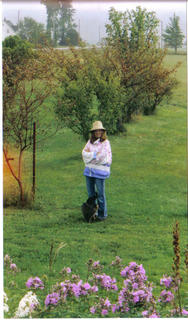
The first thing you see when you drive around the bend to Mahone Bay is four church steeples rising above the trees and reflecting in the still water of the bay.
"Where's Amos Pewter?” my father-in-law, Dave, asks as he steers the car toward Main street. We cruise past a cluster of teenagers smoking on the steps of the Lutheran church. “Amos Pewter supposed to be the best view of the churches,” he continues. Dave’s hobby is photography and we have visited several beautiful sites today. He’s collecting pictures as we go.
Pat, his wife, and I sit in the back seat watching novelty shops shuffle past the car windows while Dave and Dwayne chat in the front seats. About a quarter of a mile down the road we pass a turquoise building with lavender trim. An old wooden sign hangs above the door. “Amos Pewter!” I say, pressing my finger to the glass. Dave slides the car to a stop, parks against the sidewalk, and we get out.
Behind the shop, a small green lawn stretches away from the building and literally drops into the bay, no fence, no hedge, no barrier. Dave holds his view finder up and eyes the scenery. Only three steeples are visible from this angle and we all wonder why Dave was told this was the best picture.
“It’s not nearly as nice as the view from across the bay,” Pat says, and we all look across the water at the bend in the road where we’ve just been. Dave decides he’ll take his pictures after we’ve played tourist and are on our way out.
Inside Amos, we wander around displays of pewter objects, delicately laid in cabinets, and display booths. Some of the items our out in the open, so that Dwayne and I handle them lightly.
“Feel how heavy this is!” Dwayne says picking a sand dollar from a trough of sand. Other beach treasures cast in muted silver sit in the trough: a tiny conch, a starfish, a mermaid’s purse. I pick each up and turn it over in my fingers trying to image how they were cast, so life like, and so dead, as if turned to pewter instantly. What if Midas had a pewter touch?
At the back of the store is a workshop where guests can watch the owners make the merchandise. I wander to the back and stare mindlessly at the tourist plaques, pictures and words describing the pewter process. A woman stands behind some Plexiglas buffing a piece of pewter. She sees me and suddenly reaches her hand over the divider pushing a small Celtic cross into my face. I’m so taken off guard that I don’t hear what she’s saying. Something about what she’s doing with the pewter.
“Do you want to watch a demonstration?” she asks, cocking her head to one side. I nod my head because it’s the only thing I can think of to do in this moment. “Suzie can show you,” she says and motions to another woman who’s standing further down the bench.
I hold up my finger and say, “Just a minute. My husband will want to see this.” I spin around and trot through the store to find Dwayne. Soon a small crowd including Pat and Dave has gathered around the Plexiglas to watch as Suzie pours liquid pewter down the thin neck of a centrifuge. She dips a ladle into a silky cauldron of heated metal and spills it onto the work bench.
“It doesn’t take long to cool,” she says and we watch as the pewter hardens into a frozen river on the wood. Suzie picks it up with her bare hands, and slides it back into the melting pot.
Inside the centrifuge, while Suzie is demonstrating the amazing properties of pewter, the liquid metal is being spun through many little channels of rubber until it hits the outer most rim of the mold and settles into the delicate twists of a necklace link, or the intricate creases of a maple leaf. Each mold is different, and I can see on the bench, other designs that have just been taken from the centrifuge, dull and nearly white from workshop dust.
As I watch Suzie pour the pewter into the middle of the centrifuge I think of a fairground ride I took when I was in high school. It was the shape of a flying saucer and spun around and around so that the riders inside were held against the padded walls by a horizontal gravity. At the climax of the ride we were weightless. I remember one guy stood on the mat so that his body was perpendicular to the wall and parallel to the earth. Another person spun himself upside down so that his feet were at the top of the mat and his head at the bottom.
Had the ride stopped in that moment both people would have toppled on their heads. I was too frightened to try any of these things, so I just stayed where I was, feet off the ground, stuck to the wall. It was a few seconds of perfect release. The invisible arm of the earth had let us go, and those who were defiant railed against gravity. Others of us were timid, still psychologically bound by the world outside of the flying saucer: papers, theater jobs, dirty rooms, friends, and the carnies lazily sucking on their cigarettes.
After Amos Pewter, we walk through other novelty shops, slipping in and out of their doors, enjoying the unique trinkets and souvenirs. There is a bustle on the street, other tourists doing the same, moving in and out of shops, enjoying their vacation, a release from the everyday pull of life. For a few steps we all forget our homes and believe that this pretty town with its water as slippery as liquid pewter, reflecting back four steeples and the huddle of green trees, is as permanently picturesque as it appears.
On the way out of town, Dave, Pat, Dwayne and I sit in the car and drive back to the bend in the road where Dave takes his picture. We are sleepy from an afternoon of walking, and I put my head back on the car seat. The teenagers are still sitting on the steps of the church smoking, watching the fairground of people file through their streets.

















